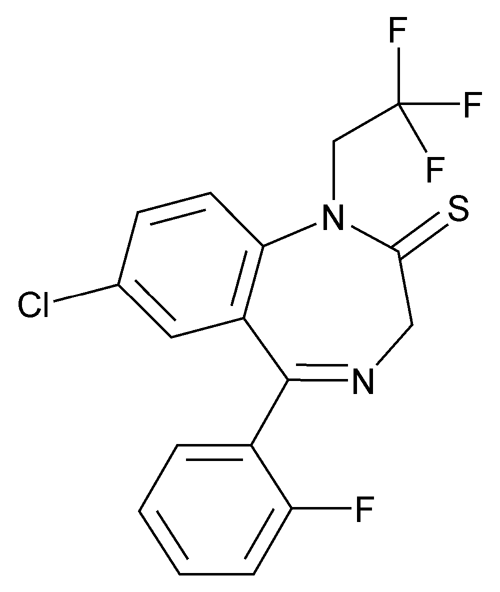Trade names Doral Routes ofadministration Oral Molar mass 386.795 g/mol | MedlinePlus a684001 ATC code N05CD10 (WHO) CAS ID 36735-22-5 | |
AHFS/Drugs.com Consumer Drug Information Pregnancycategory AU: DUS: X (Contraindicated) | ||
Quazepam (marketed under brand names Doral, Dormalin) is a benzodiazepine derivative drug developed by the Schering Corporation in the 1970s. Quazepam is indicated for the treatment of insomnia including sleep induction and sleep maintenance. Quazepam induces impairment of motor function and has hypnotic and anticonvulsant properties with less overdose potential than other benzodiazepines. Quazepam is an effective hypnotic which induces and maintains sleep without disruption of the sleep architecture. Quazepam is a trifluoroalkyl type of benzodiazepine, like fletazepam, halazepam, triflubazam and triflunordazepam. Quazepam is unique amongst benzodiazepines in that it selectively targets the GABAA α1 subunit receptors which are responsible for inducing sleep. Its mechanism of action is very similar to zolpidem and zaleplon in its pharmacology and can successfully substitute for zolpidem and zaleplon in animal studies.
Contents
- Indications
- Side effects
- Tolerance and dependence
- Special precautions
- Elderly
- Pharmacology
- Pharmacokinetics
- Interactions
- Mechanism of action
- EEG and sleep
- Drug misuse
- References
Indications

Quazepam is used for short-term treatment of insomnia related to sleep induction or sleep maintenance problems and has demonstrated superiority over other benzodiazepines such as temazepam. It had a fewer incidence of side effects than temazepam, including less sedation, amnesia, and less motor-impairment. Usual dosage is 7.5 to 15 mg orally at bedtime.
Quazepam is effective as a premedication prior to surgery.
Side effects

Quazepam has fewer side effects than other benzodiazepines and less potential to induce tolerance and rebound effects. There is significantly less potential for quazepam to induce respiratory depression or to adversely affect motor coordination than other benzodiazepines. The different side effect profile of quazepam may be due to its more selective binding profile to type 1 benzodiazepine receptors.
Tolerance and dependence

Tolerance may occur to quazepam but more slowly than seen with other benzodiazepines such as triazolam. However, quazepam causes significantly less drug tolerance and less withdrawal symptoms including less rebound insomnia upon discontinuation compared to other benzodiazepines. Quazepam may cause less rebound effects than other type1 benzodiazepine receptor selective nonbenzodiazepine drugs due to its longer half-life. Short-acting hypnotics often cause next day rebound anxiety. Quazepam due to its pharmacological profile does not cause next day rebound withdrawal effects during treatment.

No firm conclusions can be drawn, however, whether long-term use of quazepam does not produce tolerance as few, if any, long-term clinical trials extending beyond 4 weeks of chronic use have been conducted. Quazepam should be withdrawn gradually if used beyond 4 weeks of use to avoid the risk of a severe benzodiazepine withdrawal syndrome developing. Very high dosage administration over prolonged periods of time, up to 52 weeks, of quazepam in animal studies provoked severe withdrawal symptoms upon abrupt discontinuation, including excitability, hyperactivity, convulsions and the death of two of the monkeys due to withdrawal-related convulsions. More monkeys died however, in the diazepam-treated monkeys. In addition it has now been documented in the medical literature that one of the major metabolites of quazepam, N-desalkyl-2-oxoquazepam (N-desalkylflurazepam), which is long-acting and prone to accumulation, binds unselectively to benzodiazepine receptors, thus quazepam may not differ all that much pharmacologically from other benzodiazepines.
Special precautions

Benzodiazepines require special precaution if used in the during pregnancy, in children, alcohol or drug-dependent individuals and individuals with comorbid psychiatric disorders.
Quazepam and its active metabolites are excreted into breast milk.

Accumulation of one of the active metabolites of quazepam, N-desalkylflurazepam, may occur in the elderly. A lower dose may be required in the elderly.
Elderly
Quazepam is more tolerable for elderly patients compared to flurazepam due to its reduced next day impairments. However, another study showed marked next day impairments after repeated administration due to accumulation of quazepam and its long-acting metabolites. Thus the medical literature shows conflicts on quazepam's side effect profile. A further study showed significant balance impairments combined with an unstable posture after administration of quazepam in test subjects. An extensive review of the medical literature regarding the management of insomnia and the elderly found that there is considerable evidence of the effectiveness and durability of non-drug treatments for insomnia in adults of all ages and that these interventions are underutilized. Compared with the benzodiazepines including quazepam, the nonbenzodiazepine sedative/hypnotics appeared to offer few, if any, significant clinical advantages in efficacy or tolerability in elderly persons. It was found that newer agents with novel mechanisms of action and improved safety profiles, such as the melatonin agonists, hold promise for the management of chronic insomnia in elderly people. Long-term use of sedative/hypnotics for insomnia lacks an evidence base and has traditionally been discouraged for reasons that include concerns about such potential adverse drug effects as cognitive impairment (anterograde amnesia), daytime sedation, motor incoordination, and increased risk of motor vehicle accidents and falls. In addition, the effectiveness and safety of long-term use of these agents remain to be determined. It was concluded that more research is needed to evaluate the long-term effects of treatment and the most appropriate management strategy for elderly persons with chronic insomnia.
Pharmacology
Quazepam is selective for type I benzodiazepine receptors containing the α1 subunit, similar to other drugs such as zaleplon and zolpidem. As a result, quazepam has little or no muscle relaxant properties. Most other benzodiazepines are unselective and bind to type1 GABAA receptors and type2 GABAA receptors. Type1 GABAA receptors include the α1 subunit containing GABAA receptors which are responsible for hypnotic properties of the drug. Type 2 receptors include the α2, α3 and α5 subunits which are responsible for anxiolytic action, amnesia and muscle relaxant properties. Thus quazepam may have less side effects than other benzodiazepines but, it has a very long half-life of 25 hours which reduces its benefits as a hypnotic due to likely next day sedation. It also has two active metabolites with half-lives of 28 and 79 hours. Quazepam may also cause less drug tolerance than other benzodiazepines such as temazepam and triazolam perhaps due to its subtype selectivity. The longer half-life of quazepam may have the advantage however, of causing less rebound insomnia than shorter acting subtype selective nonbenzodiazepines. However, one of the major metabolites of quazepam, the N-desmethyl-2-oxoquazepam (aka N-desalkylflurazepam), binds unselectively to both type1 and type2 GABAA receptors. The N-desmethyl-2-oxoquazepam metabolite also has a very long half-life and likely contributes to the pharmacological effects of quazepam.
Pharmacokinetics
Quazepam has an absorption half-life of 0.4 hours with a peak in plasma levels after 1.75 hours. It is eliminated both renally and through feces. The active metabolites of quazepam are 2-oxoquazepam and N-desalkyl-2-oxoquazepam. The N-desalkyl-2-oxoquazepam metabolite has only limited pharmacological activity compared to the parent compound quazepam and the active metabolite 2-oxoquazepam. Quazepam and its major active metabolite 2-oxoquazepam both show high selectivity for the type1 GABAA receptors. The elimination half-life range of quazepam is between 27 and 41 hours.
Interactions
The absorption rate is likely to be significantly reduced if quazepam is taken in the fasted state reducing the hypnotic effect of quazepam. If 3 or more hours have passed since eating food then some food should be eaten before taking quazepam.
Mechanism of action
Quazepam modulates specific GABAA receptors via the benzodiazepine site on the GABAA receptor. This modulation enhances the actions of GABA, causing an increase in opening frequency of the chloride ion channel which results in an increased influx of chloride ions into the GABAA receptors. Quazepam, unique amongst benzodiazepine drugs selectively targets type1 benzodiazepine receptors which results reduced sleep latency in promotion of sleep. Quazepam also has some anticonvulsant properties.
EEG and sleep
Quazepam has potent sleep inducing and sleep maintaining properties. Studies in both animals and humans have demonstrated that EEG changes induced by quazepam resemble normal sleep patterns whereas other benzodiazepines disrupt normal sleep. Quazepam promotes slow wave sleep. This positive effect of quazepam on sleep architecture may be due to its high selectivity for type1 benzodiazepine receptors as demonstrated in animal and human studies. This makes quazepam unique in the benzodiazepine family of drugs.
Drug misuse
Quazepam is a drug with the potential for misuse. Two types of drug misuse can occur either recreational misuse is where the drug is taken to achieve a high or when the drug is continued long term against medical advice.
